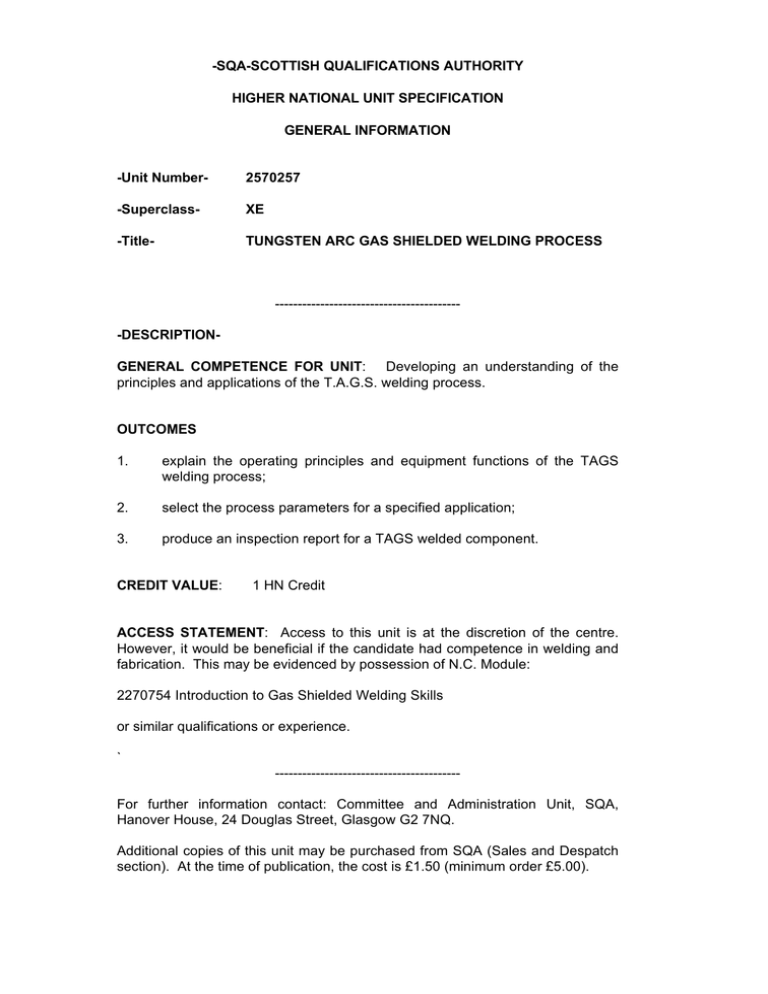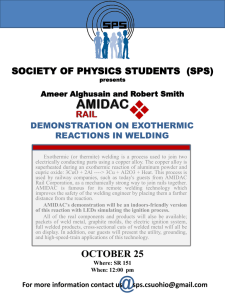Unit Number
advertisement

-SQA-SCOTTISH QUALIFICATIONS AUTHORITY HIGHER NATIONAL UNIT SPECIFICATION GENERAL INFORMATION -Unit Number- 2570257 -Superclass- XE -Title- TUNGSTEN ARC GAS SHIELDED WELDING PROCESS -----------------------------------------DESCRIPTIONGENERAL COMPETENCE FOR UNIT: Developing an understanding of the principles and applications of the T.A.G.S. welding process. OUTCOMES 1. explain the operating principles and equipment functions of the TAGS welding process; 2. select the process parameters for a specified application; 3. produce an inspection report for a TAGS welded component. CREDIT VALUE: 1 HN Credit ACCESS STATEMENT: Access to this unit is at the discretion of the centre. However, it would be beneficial if the candidate had competence in welding and fabrication. This may be evidenced by possession of N.C. Module: 2270754 Introduction to Gas Shielded Welding Skills or similar qualifications or experience. ` ----------------------------------------For further information contact: Committee and Administration Unit, SQA, Hanover House, 24 Douglas Street, Glasgow G2 7NQ. Additional copies of this unit may be purchased from SQA (Sales and Despatch section). At the time of publication, the cost is £1.50 (minimum order £5.00). Unit No. 2570257 Continuation HIGHER NATIONAL UNIT SPECIFICATION STATEMENT OF STANDARDS UNIT NUMBER: 2570257 UNIT TITLE: TUNGSTEN ARC GAS SHIELDED WELDING PROCESS Acceptable performance in this unit will be the satisfactory achievement of the standards set out in this part of the specification. All sections of the statement of standards are mandatory and cannot be altered without reference to SQA. OUTCOME 1. EXPLAIN THE OPERATING PRINCIPLES AND EQUIPMENT FUNCTIONS OF THE TAGS WELDING PROCESS PERFORMANCE CRITERIA (a) (b) (c) (d) The identification of variables affecting the arc conditions is correct. The identification of equipment components and connections is correct. The description of functions of equipment components is correct. The principles of the tags welding process is correctly described. RANGE STATEMENT Variables: heat source; voltage; current and polarity; power sources. Equipment components: suppressors; torch types; gas pressure and flow control; all inter-connecting cables and hoses; high frequency unit; surge injectors. Equipment: composite, non composite. Operating principles: limitations arc initiation, atmospheric protection; advantages; EVIDENCE REQUIREMENTS Written evidence is required to show that the candidate can outline the principles and equipment functions of the TAGS Welding Process, as specified in PCs (a) to (d). 2 Unit No. 2570257 Continuation OUTCOME 2. SELECT THE PROCESS PARAMETERS FOR A SPECIFIED APPLICATION PERFORMANCE CRITERIA (a) (b) (c) (d) The identification of the applications of the TAGS welding process is correct. The preparation of the TAGS welding equipment for use is in accordance with manufacturer’s instructions. The selection of the process variables is correct for a specified application. The selection of welding techniques is correct and appropriate for the application. RANGE STATEMENT Variables: shielding gases; electrode type; voltage; polarity; current; flow rates; material and thickness range. EVIDENCE REQUIREMENTS Performance evidence is required to show that the candidate can select process parameters as specified in PCs (a) to (d). A minimum of 2 materials must be used in the process with thickness within a 1mm to 25mm range. OUTCOME 3. PRODUCE AN INSPECTION REPORT FOR A TAGS WELDED COMPONENT PERFORMANCE CRITERIA (a) (b) (c) (d) The application of visual inspection methods to the welded joint is correct. The identification of faults and their effects on welded structure is correct. The selection of method of fault rectification is correct. The production of an inspection report is correct. RANGE STATEMENT The range for this outcome is fully expressed in the performance criteria. 3 Unit No. 2570257 Continuation EVIDENCE REQUIREMENTS Written evidence in the form of an inspection report for a TAGS welded component is required, detailing visual inspection methods, faults identified, the probable cause of these defects, the effect on the welded structure and the proposed rectification as specified in PCs (a) to (d). MERIT To gain a pass in this unit, a candidate must meet the standards set out in the outcomes, performance criteria, range statements and evidence requirements. To achieve a merit in this unit, a candidate must demonstrate a superior or more sophisticated level of performance. This may be demonstrated by: (i) showing a wide knowledge and understanding of the subject by justifying the answers to the assessments using reasoned discussion for or against a given decision. ----------------------------------------- ASSESSMENT In order to achieve this unit, candidates are required to present sufficient evidence that they have met all the performance criteria for each outcome within the range specified. Details of these requirements are given for each outcome. The assessment instruments used should follow the general guidance offered by the SQA assessment model and an integrative approach to assessment is encouraged. (See references at the end of support notes). Accurate records should be made of the assessment instruments used showing how evidence is generated for each outcome and giving marking schemes and/or checklists, etc. Records of candidates’ achievements should be kept. These records will be available for external verification. SPECIAL NEEDS Proposals to modify outcomes, range statements or agreed assessment arrangements should be discussed in the first place with the external verifier. Copyright SQA 1997 Please note that this publication may be reproduced in whole or in part for educational purposes provided that: (i) (ii) no profit is derived from the reproduction; if reproduced in part, the source is acknowledged. 4 Unit No. 2570257 Continuation HIGHER NATIONAL UNIT SPECIFICATION SUPPORT NOTES UNIT NUMBER: 2570257 UNIT TITLE: TAGS ARC GAS SHIELDED PROCESS SUPPORT NOTES: This part of the unit specification is offered as guidance. None of the sections of the support notes is mandatory. NOTIONAL DESIGN LENGTH: SQA allocates a notional design length to a unit on the basis of time estimated for achievement of the stated standards by a candidate whose starting point is as described in the access statement. The notional design length for this unit is 40 hours. The use of notional design length for programme design and timetabling is advisory only. PURPOSE This unit will familiarise candidates with the principles, equipment functions and parameters of the T.A.G.S. welding process. On completion of this unit candidates will be able to identify and describe all the equipment components, set up the equipment ready for use and complete a welded artefact in a given time. Candidates will also be able to visually inspect the welded joint for defects and write a report on this inspection. CONTENT/CONTEXT The following information gives further clarification regarding the context in which the outcomes are to be achieved. Corresponding to outcomes 1-3: Outcome 1 All variables associated with TAGS welding processes should be identified and an explanation of the effect they have on the weld quality explained. Variables such as voltage, current, electrode extension, gases used and their properties, etc. Types of power sources used should be fully explained. All equipment components used and inter-connecting cables and hoses should be fully explained and their function within the system. Outcome 2 This outcome should be undertaken in a workshop environment with the candidate having hands on experience of the process. A practical demonstration of setting up the equipment should be given followed by the candidate being given the opportunity to do the same. Typical applications of the TAGS process should be explained along with the appropriate welding techniques which would be employed for each application. The candidate should be allowed to prepare his/her own materials before completing at least two test pieces from material and thickness stated below: 5 Unit No. 2570257 Continuation low carbon steel, low alloy steel, stainless steel, aluminium and aluminium alloys, nickel and nickel alloys, copper and copper alloys. Thickness: 1mm to 25mm range. Outcome 3 Using the test pieces obtained from previous outcome the candidate would visually inspect the welds for defects. Prior to this an explanation of the types of defect which might be found in the weld, the probable cause, the effect on the welded component and an explanation of the method of rectifying the fault would be given. The inspection report would be written up using the criteria stated in the evidence requirements. APPROACHES TO GENERATING EVIDENCE As contained in content/context corresponding to outcomes. ASSESSMENT PROCEDURES Centres may use the Instruments of Assessment which are considered to be the most appropriate. Examples of Instruments of Assessment that could be used as follows: Outcome 1 PC(a) Written questions asking for an explanation of variables affecting arc conditions and the reasons for these effects. PC(b) Possibly a line drawing of T.A.G.S. set up asking for equipment and connections to be identified. PC(c) Written questions asking for a description and use of three named components. PC(d) Written question asking for a description and use of three named components. Outcome 2 Practical exercise to suit requirements of local employers. Checklist may be used to evidence the candidate knowledge of setting up equipment. Outcome 3 A written inspection report on a visual examination for weld defects is produced. PROGRESSION Successful completion of this unit would lead to a fuller understanding of unit number 2570277 Advanced Gas Shielded Welding Processes. 6 Unit No. 2570257 Continuation REFERENCES 1. 2. Guide to unit writing. For a fuller discussion on assessment issues, please refer to SQA’s Guide to Assessment. 3. Information for centres on SQA’s operating procedures is contained in SQA’s Guide to Procedures. For details of other SQA publications, please consult SQA’s publications list. 4. Copyright SQA 1997 Please note that this publication may be reproduced in whole or in part for educational purposes provided that: (i) (ii) no profit is derived from the reproduction; if reproduced in part, the source is acknowledged. 7



